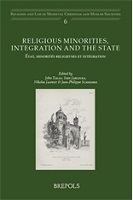Religious minorities, integration and the State; État, minorités religieuses et intégration
Contributor(s)
Tolan, John (editor)
Jablonka, Ivan (editor)
Jaspert, Nikolas (editor)
Schreiber, Jean-Philippe (editor)
Collection
European Research Council (ERC)Language
English; FrenchAbstract
Judaism, Christianity and Islam have coexisted in Europe for over 1300 years. The three monotheistic faiths differ in demography, in the moment of their arrival on the continent and in the unequal relations they maintain with power: Christianity was chosen by a large number of inhabitants and became — in spite of important differences according to place and time —a religion of state. The organization of the continent into states and the divisions within Christianity often placed minorities in an unstable and at times painful situation. This partially explains the fight against "heresies", the wars of religions, the expulsion of Jews from several European kingdoms (as well as the expulsion of Muslims from Sicily and the Iberian peninsula), the "Jewish question" in the 19th century up until the Holocaust. Since the 20th century, the debates concerning Islam and concerning public expression of religion are shaped in part by this past. The 13 studies gathered in this volume explore the ways in which states have treated their religious minorities. We study various policies — repression, supervision, integration, tolerance, secularization, indifference — as well as the many ways in which minorities have accommodated the majority’s demands. The relation is by no means one-sided: on the contrary, state policies have created resistance, negotiation (on the legal, political, and cultural fronts) or compromise. Through these precise and original examples, we can see how the protagonists (states, religious institutions, the elite, the faithful) interact, try to convince or influence each other in order to transform practices, invent and implement common norms and grounds, all the while knowing the confessional dimension of "religious" majority and minority does not fully embrace the identity of each citizen in full. Judaïsme, christianisme, islam ont en Europe une histoire millénaire. Ces monothéismes se différencient par leur poids respectif, par les moments de leur inscription sur le continent et par leurs inégaux rapports avec le pouvoir : le christianisme a été adopté par un très grand nombre d’habitants et est devenu – avec d’importantes variations selon les lieux et les époques – une religion officielle, faisant face, dès lors, à des religions minoritaires. La structuration du continent en États et la division du christianisme lui-même, entre le Moyen Age et le XVIe siècle, ont placé les minorités dans une situation souvent instable et douloureuse. Ainsi s’expliquent, pour partie, la lutte contre les « hérésies », les guerres de religion, l’expulsion des juifs de plusieurs royaumes européens (et aussi l’expulsion de Musulmans de la Sicile et de la péninsule ibérique), la « question juive » au XIXe siècle et jusqu’à la Shoah. C’est ce passé que réveille, depuis la fin du XXe siècle, le débat sur la place de l’islam et les manières de manifester sa foi dans l’espace public. Les 13 études réunies dans ce volume étudient les manières dont les États ont traité leurs minorités religieuses. On y voit des politiques diverses envers des minorités religieuses– répression, encadrement, intégration, tolérance, laïcité, indifférence – ainsi que de diverses manières dont les minorités ont accueilli les exigences de la majorité. La relation n’est pas unilatérale : au contraire, les politiques étatiques donnent lieu à des résistances, des négociations (sur le plan légal, politique, culturel, etc.) ou compromis. À l’aide d’exemples précis et originaux, on voit comment les acteurs – États, institutions religieuses, élites, fidèles – interagissent, tentent de se convaincre, s’influencent pour transformer des pratiques, mettre au point des normes communes et inventer un terrain d’entente, sachant que la dimension confessionnelle des majorités et des minorités « religieuses » n’embrasse pas la totalité de l’identité de chaque citoyen.
Keywords
religious minorities; minorités religieuses; state; integration; l'intégration; etat; France; Islam; Muslims; ParisOCN
1052103655Publisher
BrepolsPublisher website
http://www.brepols.net/Pages/Home.aspxPublication date and place
Turnhout, 2016Grantor
Series
Religion and Law in Medieval Christian and Muslim Societies, 6Classification
History
Archaeology
Religion: general


 Download
Download